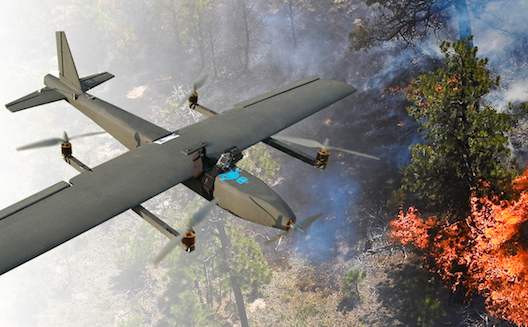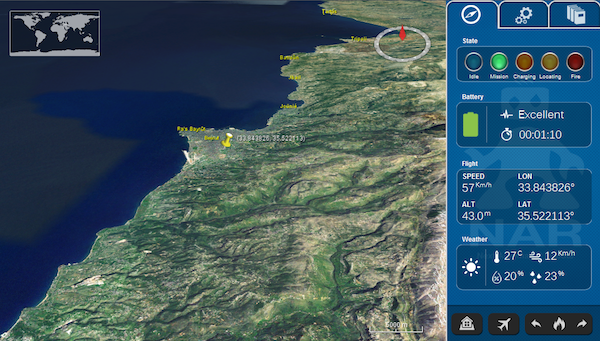Lebanese drones tackling forest fires, NAR

In 2014, when fires started raging through Nicolas Zaatar’s home district of Baabda in Lebanon, an opportunity presented itself.
He was helping the firefighters when the then-engineering student saw a vital missing link in the rescue operation chain: there was no aerial monitoring. The firefighters needed help finding and getting to the next spot that would need their attention.
“There are helicopters available when such things occur,” Zaatar told Wamda. “But the bureaucracy involved when it comes to getting one in the air is not conducive in emergency situations.”

The situation in Lebanon is lacking when it comes to fighting fires. NGOs are usually the first ones on the ground armed with sand and a shovel, followed by civil defense (they are the ones dispatched to deal with fires) who suffer from lack of resources and manpower.
So, along with some friends, and cofounder Charlie El Khoury, and as part of a final year university project in 2015, Zaatar built a small quadcopter. Three months later and it evolved into a VTOL (vertical takeoff and landing) drone, they were able to engineer a prototype that could fly for up to two hours and - better yet - resist high winds, a common ingredient in forest fires.

Say ‘no’ to military
Now with their startup Next Automated Robots (NAR), Zaatar and El Khoury, plus Joe El Asmar and Ziad Jreijiry, are “developing smart drones with industrial applications” they have advanced from the quadcopter and now have three testing drones.
Each have a two meter wingspan and weigh about three kilos (a military drone can measure up to 40 meters), is built with a thermal camera, can be operated from a desktop application, and can fly between 100 and 200 meters in the air.
Wanting to take into account non-tech savvy users, the desktop application means that anyone can operate the drone. The military equivalent, aside from the bureaucracy around getting one off the ground, can only be flown by a trained military pilot. NAR’s application allows the user to guide the drone by simply adding map coordinates. There is also an emergency landing feature.
The “brain”, as Zaatar calls it, is the processor chip contained within the drone that processes images from a camera and communicates them back to the flight controller. “If the processor detects a fire in the image it will communicate that image back to the authority [pilot], giving them the location,” said Zaatar.
Importing all parts from elsewhere in the region, as well as the US and Europe (no intrinsic parts were sourced in Lebanon) they have been funded so far by Kafalat’s iSME program, the accelerator Speed@BDD. They are now looking for further investment.
Franck Keszi of Terre Liban, the NGO fighting those fires back in 2014, told Wamda that they hadn’t used the drones yet except in practice “but we aim to acquire drones for the protection of our forest and we hope that we will be able to promote massively the usage of the NAR product for Mediterranean forests protection”.
Keszi said it was the windy days that made it particularly hard to detect exactly where a fire’s source was and that a drone would enable them to track this, as well as the progression of the fire in realtime. “This is a major improvement in the forest fighting without the very expensive costs of helicopter or airplanes.”
Foreign conquests
Despite only being patented in Lebanon NAR’s ambitions go far beyond the Middle East.

Forest fires are the scourge of countries across Europe, Asia and the US - the Middle East isn’t exactly a big market for the team, and so they are looking elsewhere to sell their product.
On a recent trip to Silicon Valley, courtesy of Speed Accelerator and Blackbox VC, Zaatar was keen to dip his toe into a potential market (California itself has an average of 8,000 forest fires a year).
The feedback was encouraging. Not dissimilar from the situation in Lebanon, fire services in the US do not have easy access to aerial monitoring. Fire services currently use military ones but they are much smaller and far less accessible - bureaucracy - and they require a professional to drive them.
As well as meeting with an interested water bombing company in California, NAR has been in talks with the US Forest Service's international programs.
“The US fire service people are interested in this technology because they send helicopters during storms to locate a fire caused by a thunder,” Zaatar told Wamda. “Our drone could be useful in these kind of situations.”
So interesting was the trip to the valley that the NAR team are now making a sort of pivot.
While still developing their drones for the monitoring of wildfires, they are shifting focus to the development of the ‘brain’ system that will be integrated onto other drones used in the detection of fires.

“We are targeting the exact same people with the exact same drone-solution,” Zaatar said. “In other words, we will still sell an entire solution [drone plus system that makes the drone smart enough to monitor wildfires].”
Accessing other markets is something they hope to do. The desire is that such a partnership will help them display a proof of concept, making it easier for them to break into foreign markets.
Regional competition
Aside from a more recent look at drones as a friendly solution, like the UAE’s ‘Drones for good’ annual competition, the drones’ use in the Middle East still largely has negative connotations.
So, when it comes to those working with drones for more domestic uses, competition is limited, but still present. At the moment Zaatar says that US-borne Skyfire Consulting (which has an office in UAE), is their biggest competition.
Their combination of drones (from DJI) and thermal imaging (from Flir), respectively, is competition to NAR. But Zaatar isn’t flustered.
“Their disadvantage though is that they’re still using quadcopters, they can only be in the air for 15 minutes at a time and are not wind resistant.”
So while they’re keen to get their product off the ground, pun intended, elsewhere in the world, they do still stress their obligation to their country and won’t be rushing off any time soon. “Our priority is to help Lebanon,” said Zataar.


